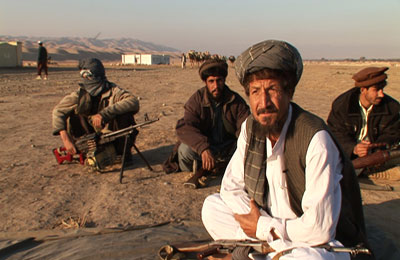Introduction
February 23, 2010

Afghan villagers who support the Taliban
This past fall, veteran Afghan journalist Najibullah Quraishi negotiated extraordinary access to a militant cell in northern Afghanistan with longtime ties to Al Qaeda and the Taliban. For 10 days, Quraishi would live among the hard-core fighters of Hezb-i-Islami's "Central Group" as they attempt to bomb a highway that has become a vital new coalition supply route.
"I was thinking that I'm going to meet a group of Taliban," Quraishi tells FRONTLINE. "I was thinking, this is the time which I came myself to enemy. I was thinking they might not let me go back."
In Behind Taliban Lines, FRONTLINE provides a rare glimpse into the inner workings of the growing insurgency in Afghanistan -- a first-ever film among these militants as they travel from village to village, picking up support and weapons, imposing sharia law and collecting taxes as they open up a new battlefront in Afghanistan's northern provinces.
"We have around 3,000 to 4,000 Hezb-i-Islami men in the north," a commander named Kalaqub tells Quraishi."People come to us from all over Afghanistan. … They come from Chechnya, Uzbekistan, Kazakhstan, Tajikistan. We get special mujahids from abroad, but we're not allowed to talk about them." Quraishi believes that these special mujahids are mainly Arabs from Yemen and Saudi Arabia trained by Al Qaeda.
Indeed, as the men of Central Group proceed toward their target, Quraishi meets a young bomb maker from Uzbekistan who says he was trained by Al Qaeda.
"America started this war in Afghanistan so that European countries like England and America would be safe," he tells Quraishi. "But they should know that once the mujahideen conquer Afghanistan, … we'll aim for the Middle East and Europe."
Quraishi films the men of Central Group building the IEDs, the improvised explosive devices -- stuffing the shells with gunpowder, wiring the blast cap -- and talking about the damage they hope to inflict: "This will pop out the eyes of the Americans," one says. "The fire, smoke and debris will cover 50 to 100 square meters." After a suspenseful night spent waiting in the field, the insurgents' plan is ultimately foiled when the bombs fail to detonate.
Quraishi manages to interview the man in charge of some 4,000 Hezb-i-Islami fighters in the north. His name is Cmdr. Mirwais, a former millionaire businessman who turned to jihad after the U.S. invasion of Afghanistan. "Jihad has become a duty for all the Afghan nation because the foreign and non-believer countries have attacked us," Mirwais says. "They're getting rid of our religious and cultural values in Afghanistan. They've increased obscenity and want to force Western democracy on our country."
It was Cmdr. Mirwais who first invited Quraishi to live among the insurgents as a guest, following the journalist's contact with a Taliban intermediary late last summer. And, after some 10 days of filming, it was Cmdr. Mirwais who Quraishi says may have helped save his life.
"Mirwais took my hand; he took me aside," Quraishi says."He said: 'Brother, I invited you here as a guest. I know your plan is to be here for 14 days, but I'm really sorry.'" Two men had arrived from Pakistan -- likely from Hezb-i-Islami and Al Qaeda -- and they demanded to know why an outsider had been allowed in to film among the fighters. "'They keep telling me that you are a spy and we have to behead you.'"
Quraishi escapes and decides to revisit the place on the highway where he'd witnessed the insurgents planting their roadside bombs. In a telling scene near the end of the film, the local Afghan police seem not to appreciate -- or even to acknowledge -- the extent of the insurgent threat in the north. "Everything's fine," the police chief says. "There's no problem. They've caused some problems, but everything's fine in this area near the main road. It's not a problem."